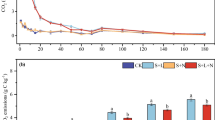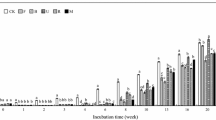Abstract
Nitrogen (N) is a crucial nutrient for soil biota, and its cycling is determined by the organic carbon decomposing process. Some endophytic fungi are latent saprotrophs that trigger their saprotrophic metabolism to promote litter organic matter cycling as soon as the host tissue senesces or dies. However, the effects of endophytic fungi on litter and soil N dynamics in vitro have rarely been investigated. In this study, we investigated N dynamics (total and mineral N) in both litter and soil in incubations of a pure culture of an endophytic fungus Phomopsis liquidambari with litter and following soil burial of the litter. Soil enzymes and microbial communities participating in the N transformations were also investigated. A pure culture of P. liquidambari released litter NH +4 –N in the initial stages (10 days) of the incubation. However, following soil burial, the presence of both P. liquidambari and soil ammonia-oxidizing bacteria (AOB) resulted in an increase in soil NO −3 –N. These results indicate that the endophytic fungus P. liquidambari in vitro stimulates organic mineralization and promote NH +4 –N release. Such effects triggered soil AOB-driven nitrification process.




Similar content being viewed by others
References
Abdelmagid HM, Tabatabai MA (1987) Nitrate reductase activity of soils. Soil Biol Biochem 19:421–427
Allison SM, Prosser JI (1991) Urease activity in neutrophilic autotrophic ammonia-oxidizing bacteria isolated from acid soils. Soil Biol Biochem 23:45–51
Bagwell CE, La Rocque JR, Smith GW, Polson SW, Friez MJ, Longshore JW, Lovell CR (2002) Molecular diversity of diazotrophs in oligotrophic tropical seagrass bed communities. FEMS Microbiol Ecol 39:113–119
Bürgmann H, Meier S, Bunge MW, Widmer F, Zeyer J (2005) Effects of model root exudates on structure and activity of a soil diazotroph community. Environ Microbiol 7:1711–1724
Burke DJ, Weintraub MN, Hewins CR, Kalisz S (2011) Relationship between soil enzyme activities, nutrient cycling and soil fungal communities in a northern hardwood forest. Soil Biol Biochem 43:795–803
Cairney JWG, Burke RM (1998) Extracellular enzyme activities of the ericoid mycorrhizal endophyte Hymenoscyphus ericae (Read) Korf & Kernan: their likely roles in decomposition of dead plant tissue in soil. Plant Soil 205:181–192
Casida LE, Klein DA, Santoro T (1964) Soil dehydrogenase activity. Soil Sci 98:371–376
Carrillo Y, Ball BA, Bradford MA, Jordan CF, Molina M (2011) Soil fauna alter the effects of litter composition on nitrogen cycling in a mineral soil. Soil Biol Biochem 43:1440–1449
Chaeprasert S, Piapukiew J, Whalley AJS, Sihanonth P (2010) Endophytic fungi from mangrove plant species of Thailand: their antimicrobial and anticancer potentials. Bot Mar 53:555–564
Chapman SK, Langley JA, Hart SC, Koch GW (2006) Plants actively control nitrogen cycling: uncorking the microbial bottleneck. New Phytol 169:27–34
Chen Y, Dai CC, Zhang B, Ju Q, Wang XX (2010) Effects of endophytic fungus (Phomopsis sp.) on decomposition of plant (Atractylodes lancea (Thunb) DC.) litters and activity of degrading enzymes in soil. Acta Pedolgica Sinica 47:537–544
Chen Y, Peng Y, Dai CC, Ju Q (2011) Biodegradation of 4-hydroxybenzoic acid by Phomopsis liquidambari. Appl Soil Ecol 51:102–110
Chigineva NI, Aleksandrova AV, Marhan S, Kandeler E, Tiunov AV (2011) The importance of mycelial connection at the soil–litter interface for nutrient translocation, enzyme activity and litter decomposition. Appl Soil Ecol 51:35–41
Christias C, Couvaraki C, Georgopoulos SG, Macris B, Vomvoyanni V (1975) Protein content and amino acid composition of certain fungi evaluated for microbial protein production. Appl Microbiol 29:250–254
Cochrane VW (1958) Physiology of fungi. Wiley, New York
Dai CC, Chen Y, Tian LS, Shi Y (2010) Correlation between invasion by endophytic fungus Phomopsis sp. and enzyme production. Afr J Agric Res 5:1324–1330
De Boer W, Kowalchuk GA (2001) Nitrification in acid soils: microorganisms and mechanisms. Soil Biol Biochem 33:853–866
Dick RP (1994) Soil enzyme activities as indicators of soil quality. In: Doran, J.W (Ed.), Defining soil quality for a sustainable environment, SSSA Special Publication no. 35, 107–124.
Dijkstra FA, Bader NE, Johnson DW, Cheng WX (2009) Does accelerated soil organic matter decomposition in the presence of plants increase plant N availability? Soil Biol Biochem 41:1080–1087
Eivazi F, Bayan MR (1996) Effects of long-term prescribed burning on the activity of select soil enzymes in an oak-hickory forest. Can J For Res 26:1799–1804
Falkowski PG, Fenchel T, Delong EF (2008) The microbial engines that drive Earth’s biogeochemical cycles. Science 320:1034–1039
Fan FL, Zhang FS, Lu YH (2011) Linking plant identity and interspecific competition to soil nitrogen cycling through ammonia oxidizer communities. Soil Biol Biochem 43:46–54
Fontaine S, Henault C, Aamor A, Bdioui N, Bloor JMG, Maire V, Mary B, Revaillot S, Maron PA (2011) Fungi mediate long term sequestration of carbon and nitrogen in soil through their priming effect. Soil Biol Biochem 43:86–96
Francis CA, Roberts KJ, Beman JM, Santoro AE, Oakley BB (2005) Ubiquity and diversity of ammonia-oxidizing Archaea in water columns and sediments of the ocean. Proc Natl Acad Sci U S A 102:14683–14688
Frey SD, Six J, Elliott ET (2003) Reciprocal transfer of carbon and nitrogen by decomposer fungi at the soil–litter interface. Soil Biol Biochem 35:1001–1004
Fukasawa Y, Osono T, Takeda H (2009) Effects of attack of saprobic fungi on twig litter decomposition by endophytic fungi. Ecol Res 24:1067–1073
Geisseler D, Horwath WR, Joergensen RG, Ludwig B (2010) Pathways of nitrogen utilization by soil microorganisms—a review. Soil Biol Biochem 42:2058–2067
Gruber N, Galloway JN (2008) An Earth-system perspective of the global nitrogen cycle. Nature 451:293–296
Hawkes CV, Wren IF, Herman DJ, Firestone MK (2005) Plant invasion alters nitrogen cycling by modifying the soil nitrifying community. Ecol Lett 8:976–985
He JZ, Shen JP, Zhang LM, Zhu YG, Zheng YM, Xu MG, Di H (2007) Quantitative analyses of the abundance and composition of ammonia-oxidizing bacteria and ammonia-oxidizing archaea of a Chinese upland red soil under long-term fertilization practices. Environ Microbiol 9:2364–2374
Huang WY, Cai YZ, Hyde KD, Corke H, Sun M (2008) Biodiversity of endophytic fungi associated with 29 traditional Chinese medicinal plants. Fungal Divers 33:61–75
Isobe K, Koba K, Otsuka S, Senoo K (2011) Nitrification and nitrifying microbial communities in forest soils. J Forest Res 16:351–362
Jia ZJ, Conrad R (2009) Bacteria rather than archaea dominate microbial ammonia oxidation in an agricultural soil. Environ Microbiol 11:1658–1671
Jiang QQ, Bakken LR (1999) Comparison of nitrosospira strains isolated from terrestrial environments. FEMS Microbiol Ecol 30:171–186
Jones DL, Hodge A, Kuzyakov Y (2004) Plant and mycorrhizal regulation of rhizodeposition. New Phytol 163:459–480
Kaye JP, Hart SC (1997) Competition for nitrogen between plants and soil microorganisms. Trends Ecol Evol 12:139–143
Klose S, Tabatabai MA (1999) Urease activity of microbial biomass in soils. Soil Biol Biochem 31:205–211
Könneke M, Bernhard AE, de la Torre JR, Walker CB, Waterbury JB, Stahl DA (2005) Isolation of an autotrophic ammonia-oxidizing marine archaeon. Nature 437:543–546
Koops HP, Purkhold U, Pommerening-Roser A, Timmermann G, Wagner M (2006) The lithoautotrophic ammonia-oxidizing bacteria. In: Dworkin M, Falkow S, Rosenberg S, Schleifer KH, Strackebrandt E (eds) The prokaryotes. Springer, Heidelberg, pp 778–811
Korkama-Rajala T, Mueller MM, Pennanen T (2008) Decomposition and fungi of needle litter from slow- and fast-growing Norway spruce (Picea abies) clones. Microb Ecol 56:76–89
Kögel Kanbner I (2002) The macromolecular organic composition of plant and microbial residues as inputs to soil organic matter. Soil Biol Biochem 34:139–162
Leininger S, Urich T, Schloter M, Schwark L, Qi J, Nicol GW, Prosser JI, Schuster SC, Schleper C (2006) Archaea predominate among ammonia-oxidizing prokaryotes in soils. Nature 442:806–809
Li X, Wang C, Ren CG, Dai CC (2009) Effect of endophytic fungus B3 and different amounts of nitrogen applied on growth and yield in rice (Oriza sativa L.). Jiangsu J Agric Sci 25:1207–1212
Maehara S, Simanjuntak P, Ohashi K, Shibbuya H (2010) Composition of endophytic fungi living in Cinchona ledgeriana (Rubiaceae). J Nat Med 64:227–230
Magasanik B (1993) The regulation of nitrogen utilization in enteric bacteria. J Cell Biochem 51:34–40
Melillo JM, Aber JD, Muratore JF (1982) Nitrogen and lignin control of hardwood leaf litter decomposition dynamics. Ecology 63:621–626
Muller MM, Valjakka R, Suokko A, Hantula J (2001) Diversity of endophytic fungi of single Norway spruce needles and their role as pioneer decomposers. Mol Ecol 10:1801–1810
Nugroho RA, Röling WFM, Laverman AM, Zoomer HR, Verhoef HA (2005) Presence of Nitrosospira cluster 2 bacteria corresponds to N transformation rates in nine acid Scots pine forest soils. FEMS Microbiol Ecol 53:473–481
Osono T, Hobara S, Hishinuma T, Azuma J (2011) Selective lignin decomposition and nitrogen mineralization in forest litter colonized by Clitocybe sp. Eur J Soil Biol 47:114–121
Porras-Alfaro A, Bayman P (2011) Hidden fungi, emergent properties: endophytes and microbiomes. Annu Rev Phytopathol 49:291–315
Porras-Alfaro A, Herrera J, Odenbach K, Lowrey T, Sinsabaugh RL, Natvig DO (2008) A novel root fungal consortium associated with a dominant desert grass. Appl Environ Microbiol 74:2805–2813
Parton W, Silver WL, Burke IC, Grassens L, Harmon ME, Currie WS, King JY, Adair EC, Brandt LA, Hart SC, Fasth B (2007) Global-scale similarities in nitrogen release patterns during long-term decomposition. Science 315:361–364
Promputtha I, Hyde KD, McKenzie EHC, Peberdy FJ, Lumyong S (2010) Can leaf degrading enzymes provide evidence that endophytic fungi becoming saprobes? Fungal Divers 41:89–99
Promputtha I, Lumyong S, Dhanasekaran V, McKenzie EHC, Hyde KD, Jeewon RA (2007) Phylogenetic evaluation of whether endophytes become saprotrophs at host senescence. Microb Ecol 53:579–590
Raymond J, Siefert JL, Staples CR, Blankenship RE (2004) The natural history of nitrogen fixation. Mol Biol Evol 21:541–554
Rocha ACS, Garcia D, Uetanabaro APT, Carneiro RTO, Araujo IS, Mattos CRR, Aristoteles GN (2011) Foliar endophytic fungi from Hevea brasiliensis and their antagonism on Microcyclus ulei. Fungal Divers 47:75–84
Roesch LFW, Fulthorpe RR, Riva A, Casella G, Hadwin AKM, Kent AD, Daroub SH, Camargo FA, Farmerie WG, Triplett EW (2007) Pyro sequencing enumerates and contrasts soil microbial diversity. ISME J 1:283–290
Rotthauwe JH, Witzel KP, Liesack W (1997) The ammonia monooxygenase structural gene amoA as a functional marker: molecular fine-scale analysis of natural ammonia-oxidizing populations. Appl Environ Microbiol 63:4704–4712
Shi Y, Dai CC, Wu YC, Yuan ZL (2004) Study on the degradation of wheat straw by endophytic fungi. Acta Scientiae Circum Stantiae 24:144–149
Sun X, Guo LD, Hyde KD (2011) Community composition of endophytic fungi in Acer truncatum and their role in decomposition. Fungal Divers 47:85–95
Tian LS, Dai CC, Zhao YT, Zhao M, Yong YH, Wang XX (2007) The degradation of phenanthrene by endophytic fungi Phomopsis sp. single and co-cultured with rice. China Environ Sci 27:757–762
Viousek PM, Howarth RW (1991) Nitrogen limitation on land and in the sea: how can it occur? Biogeochemistry 13:87–115
Wartiainen I, Eriksson T, Zheng WW, Rasmussen U (2008) Variation in the active diazotrophic community in rice paddy—nifH PCR-DGGE analysis of rhizosphere and bulk soil. Appl Soil Ecol 39:65–75
Yamanaka T, Hirai K, Aizawa S, Yoshinaga S, Takahashi M (2011) Nitrogen-fixing activity in decomposing litter of three tree species at a watershed in eastern Japan. J Forest Res 16:1–7
Zehr JP, Jenkins BD, Short SM, Steward GF (2003) Nitrogenase gene diversity and microbial community structure: a cross-system comparison. Environ Microbiol 5:539–554
Zhang LM, Hu HW, Shen JP, He JZ (2012) Ammonia-oxidizing archaea have more important role than ammonia-oxidizing bacteria in ammonia oxidation of strongly acidic soil. ISME J 6:1032–1045
Acknowledgments
We are grateful to the National Natural Science Foundation of China (NSFC no.30970523, no.31070443), Innovovation Fund for Technology Based Firms of China (no.08C26213200571 ), a project funded by the Priority Academic Program Development of Jiangsu Higher Education Institutions for their financial support. We also express our great thanks to the reviewers and editorial staff for their time and attention.
Author information
Authors and Affiliations
Corresponding author
Electronic supplementary material
Below is the link to the electronic supplementary material.
ESM 1
(DOC 595 kb)
Rights and permissions
About this article
Cite this article
Chen, Y., Ren, CG., Yang, B. et al. Priming Effects of the Endophytic Fungus Phomopsis liquidambari on Soil Mineral N Transformations. Microb Ecol 65, 161–170 (2013). https://doi.org/10.1007/s00248-012-0093-z
Received:
Accepted:
Published:
Issue Date:
DOI: https://doi.org/10.1007/s00248-012-0093-z




